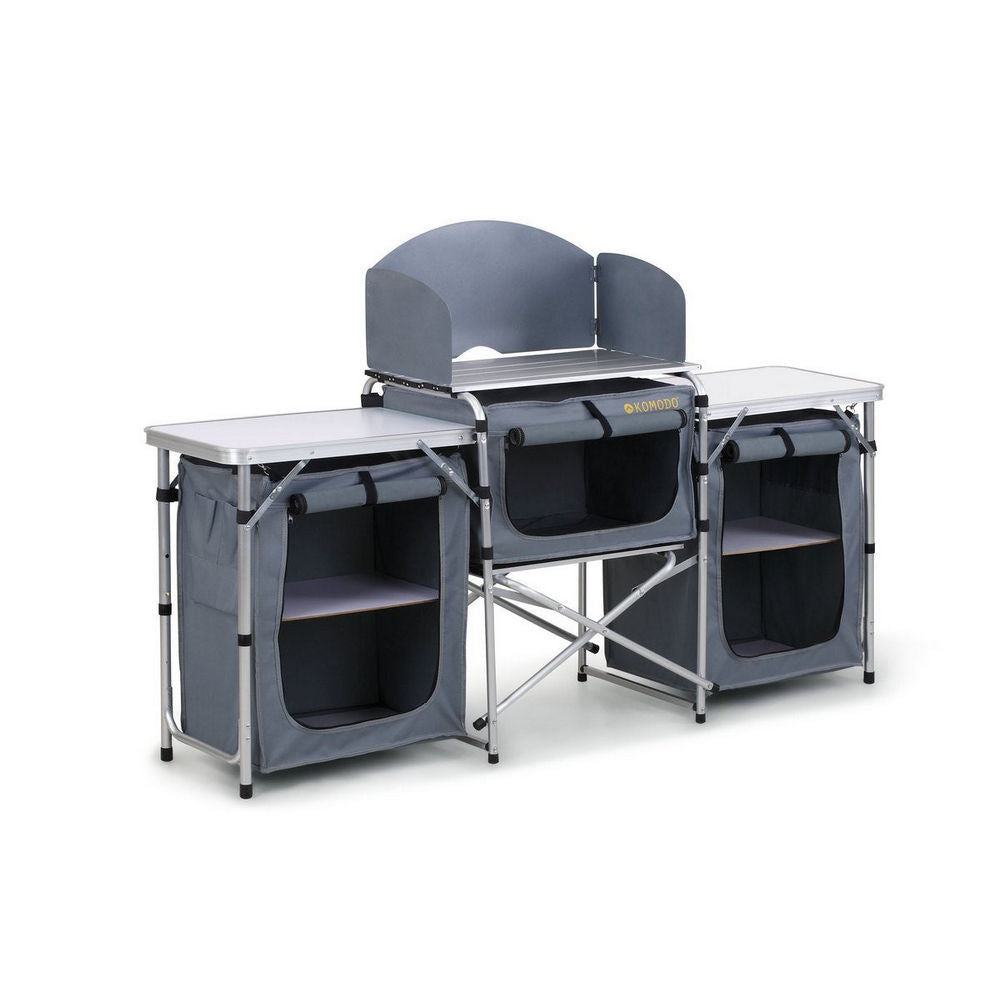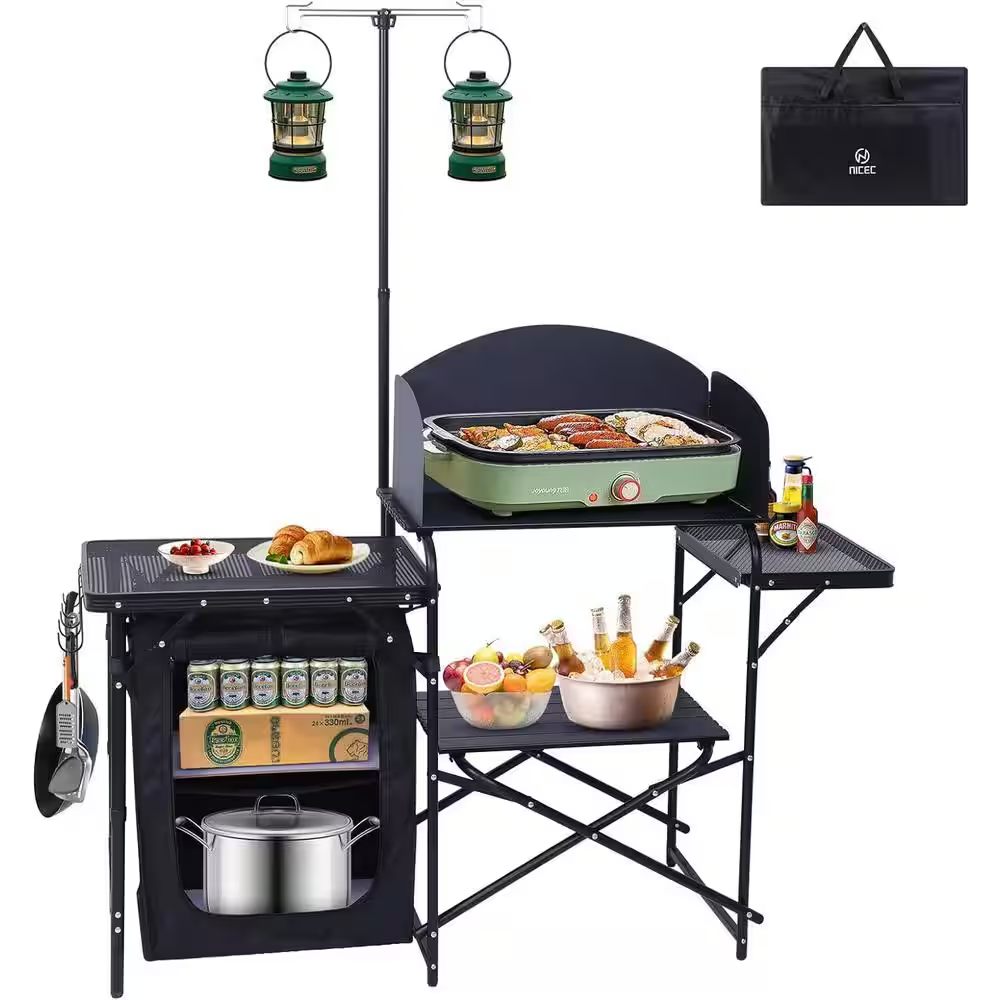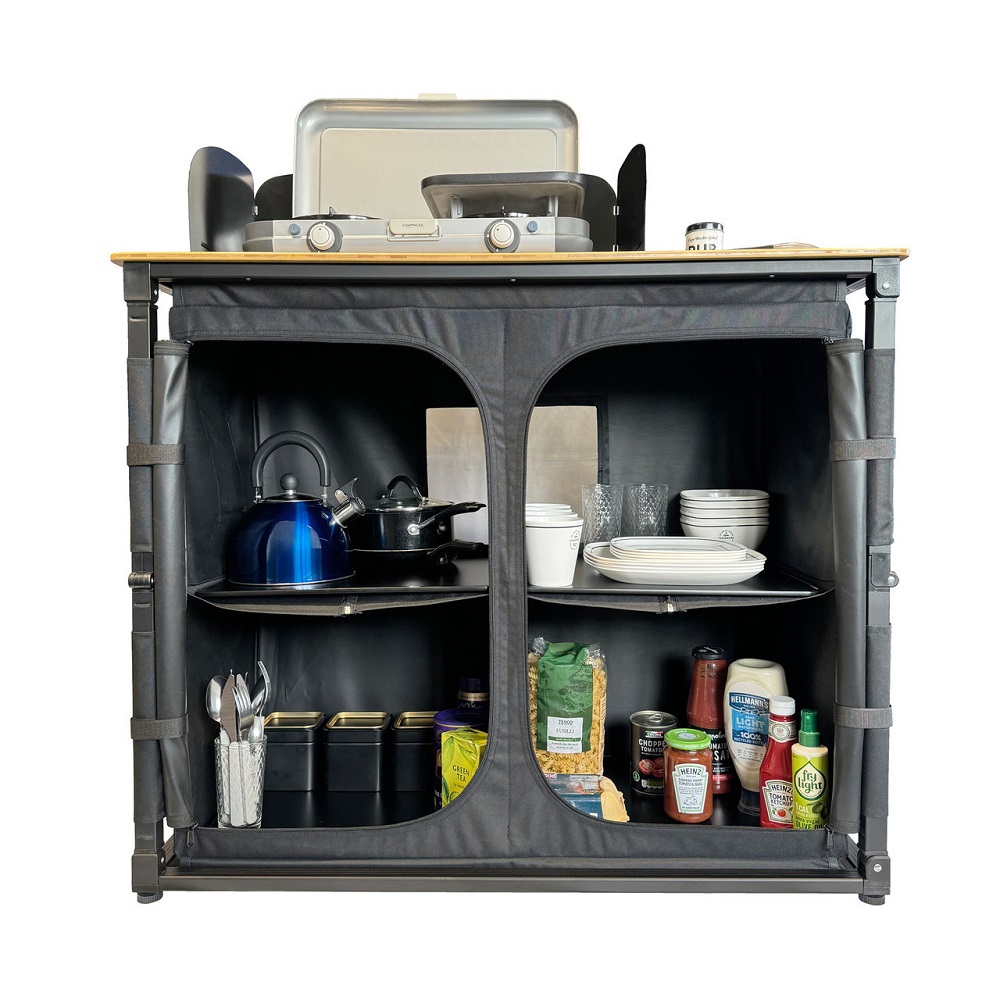Key Considerations When Setting Up a Camping Kitchen
When planning a camping kitchen, thoughtful preparation is key. The right setup ensures a better outdoor cooking experience. Consider these important factors:
Space and Portability
Space and portability are critical for a camping kitchen. Choose compact gear that saves space. Foldable tables and stackable cookware work well. Lightweight equipment makes transportation easier. Assess your vehicle’s storage capacity before packing. Balancing functionality with space efficiency is essential.
Portable setups ensure smooth operation during trips. Opt for gear designed for easy assembly. Items like collapsible sinks and folding chairs add convenience. Make sure all equipment fits securely in your camping area.
Essential Features to Look For
Prioritize equipment with multifunctional features. Look for stoves with adjustable flames. Wind-resistant designs improve efficiency for outdoor conditions. Consider grills that double as warming racks.
Durability is also a must. Outdoor gear faces rough weather and frequent handling. Choose tools made from sturdy materials like stainless steel or aluminum. Easy-to-clean designs save time and effort during your trip.
Efficiency is another important feature. Opt for tools that require minimal fuel or power. Choose energy-efficient lanterns or solar-powered appliances. Compact and versatile tools reduce the need for extra gear.
By focusing on these factors, you’ll create a camping kitchen that’s functional, portable, and durable.

Must-Have Cooking Equipment for Camping
The right cooking equipment can make outdoor cooking simple and enjoyable. Every camper needs reliable, compact gear for efficient meal preparation.
Portable Stoves and Burners
Portable stoves are essential for cooking in the wild. Choose lightweight options for easy transport. Look for stoves with adjustable flames for precise heat control. Consider models designed to handle windy conditions. Dual-fuel stoves provide versatility for different fuel types. Multi-burner stoves are excellent for cooking multiple dishes at once. Ensure your stove is durable and weather-resistant.
Burners add convenience to a camping kitchen setup. Their compact designs make transportation hassle-free. Look for efficient burners that use minimal fuel. Choose designs with easy ignition for quick meal preparation. Prioritize models with sturdy support to hold pots and pans securely.
Pots, Pans, and Cookware Sets
Cooking outdoors requires sturdy and practical cookware. Pick pots and pans made of lightweight materials like aluminum or titanium. These are durable and easy to clean. Non-stick surfaces reduce food residue and speed up cleanup. Opt for nesting cookware sets that save space. Foldable handles make cookware more portable and easier to store.
Consider pots with tight-fitting lids for even and faster cooking. Deep pans are versatile for frying or simmering meals. Collapsible or multi-purpose cookware enhances functionality while saving space. For larger groups, include larger pots or pans in your essentials. Reliable cookware ensures easy and stress-free campfire cooking.

Cooking Utensils You Should Pack
When preparing your camping kitchen, cooking utensils are as vital as any other gear. Packing lightweight, versatile tools ensures you can cook efficiently. Choose items that are durable, compact, and easy to clean.
Knives, Cutting Boards, and Tongs
A sharp, reliable knife is essential for chopping and slicing. Opt for a small chef’s knife or a folding blade for portability. Pair it with a lightweight cutting board made from durable plastic or bamboo. Cutting boards with juice grooves can prevent spills when slicing meat or fruits.
Tongs are crucial for grilling and handling hot food. Look for stainless steel tongs with a firm grip. If space is a concern, consider tongs with foldable designs. They help you cook safely and keep your hands away from heat. These three items form the backbone of any outdoor cooking setup.
Measuring Tools and Mixing Equipment
Accurate measurements make recipes easier to follow, even outdoors. Include compact measuring cups and spoons in your camping kit. Opt for nesting designs to save space.
Mixing equipment is also important for preparing sauces, marinades, or batters. A collapsible mixing bowl can handle various tasks while minimizing storage needs. Silicone or lightweight plastic bowls are great options. Don’t forget a whisk or a spatula for stirring and combining ingredients efficiently.
By packing these essential utensils, your camping kitchen will be well-equipped to handle any recipe.

Food Storage and Preservation Tips
Proper food storage is crucial for maintaining safety and freshness during camping trips. Having the right tools and strategies ensures your ingredients stay edible and organized.
Coolers and Refrigeration Options
Coolers are essential for keeping perishable items fresh. Choose a high-quality cooler with thick insulation. Consider rotomolded models for maximum ice retention. Use block ice or ice packs for longer-lasting cooling. Pre-chill your cooler to improve efficiency before packing.
If you camp frequently, portable refrigerators are worth considering. They provide reliable temperature control. Look for energy-efficient models with dual power options, like electricity and a car adapter. Use a separate cooler for drinks to minimize opening your main food cooler.
Always keep raw meats sealed and stored at the bottom to avoid contamination. Monitor the cooler’s temperature with a thermometer; aim for below 40°F.
Airtight Containers and Dry Bags
Airtight containers prevent moisture and pests from ruining your dry goods. Use BPA-free containers for storing snacks, grains, or spices. Opt for stackable designs to save space. Transparent containers make it easier to find what you need without unpacking everything.
Dry bags are invaluable for safeguarding food in wet environments. They keep non-perishable items secure and dry. Look for bags with roll-top closures for a watertight seal. Use them to keep items like bread, crackers, or cereals safe from rain or spills.
Label your containers or bags for quick identification. Proper packing and organization of your camping kitchen will make meal preparation more efficient.

Cleaning Supplies for Your Camping Kitchen
A clean camping kitchen is essential for hygiene and safety. Carrying the right cleaning supplies helps you maintain an organized and sanitary workspace. Consider lightweight, efficient, and eco-friendly options to simplify the process.
Biodegradable Soap and Sponges
Biodegradable soap is essential for cleaning dishes while protecting the environment. Choose eco-friendly soaps that effectively cut through grease. These soaps break down naturally without polluting nearby water bodies.
Sponges are necessary for scrubbing cookware and utensils. Opt for compact, quick-drying sponges to save space. Dual-sided sponges with a scrubbing pad are excellent for stubborn residue. Replace sponges after extended use to maintain cleanliness.
When washing, use a portable sink or a basin to contain waste water. Dispose of soapy water at least 200 feet from natural water sources. This practice prevents contamination and preserves the environment.
Trash Disposal and Waste Management
Proper trash disposal is critical when camping. Always pack trash bags to collect food scraps and packaging. Use durable, tear-resistant bags to avoid spills. Separate recyclables, compostable waste, and non-recyclables for easier disposal later.
Consider bringing a small collapsible trash can for convenience. This keeps your camping area clean and organized. Empty your trash bags at designated disposal sites before leaving.
For food waste, use odor-proof bags to avoid attracting wildlife. Store these bags away from your sleeping and cooking areas. Follow Leave No Trace principles to minimize your environmental impact by removing all trash when you leave.
By carrying the right cleaning supplies, you can maintain a tidy camping kitchen and protect nature.

Bonus Gadgets for a Convenience-Driven Camping Kitchen
Adding a few bonus gadgets can greatly improve your camping kitchen’s efficiency. These tools save time and effort while offering added comfort. Compact and multifunctional designs are best for reducing storage demands.
Coffee Makers and Grinders
A portable coffee maker is perfect for starting your day with a warm cup of coffee. Look for lightweight options like French presses, pour-over kits, or single-serve pod makers. These are easy to pack and require minimal setup.
For fresh grounds, a manual coffee grinder is an excellent addition. Choose a compact grinder with adjustable settings to customize your brew. Some models even combine a grinder with a pour-over system for convenience.
Consider battery-operated coffee makers for quick results. They are ideal for solo campers or small groups. Prioritize gadgets that are easy to clean and durable for outdoor use. With the right tools, you won’t need to sacrifice great coffee during your trip.
Multi-Tool Cooking Accessories
Multi-tool cooking gadgets save space and simplify meal preparation. A spork combines a spoon and fork and is lightweight. Look for high-quality materials like stainless steel or durable plastic.
Multifunctional spatulas that double as turners and scrapers are great additions. Some models even include bottle openers. For grilling, consider tools that combine tongs, a knife, and a bottle opener in one.
Can openers with added functions, like corkscrews or knife sharpeners, are also helpful. Compact options avoid taking valuable space in your camping kitchen.
Collapsible gadgets like silicone bowls that serve multiple purposes are also worth considering. These tools ensure you have versatile options while keeping your gear lightweight and portable.
Tips for Organizing Your Camping Kitchen
Organizing your camping kitchen improves efficiency and reduces stress during outdoor adventures. Proper packing and planning are essential for creating a functional and tidy setup.
Packing Efficiently
Packing efficiently can save space and make meal preparation easier. Start by creating a checklist of essential cooking items. Include compact gear like foldable tables and nesting cookware sets. Minimize bulky items that take up unnecessary space.
Use stackable containers to store ingredients and dry goods. Transparent containers help you quickly locate items without unpacking every container. Organize tools like knives, tongs, and measuring cups in a portable caddy or a small bag.
Pack perishable items separately in a cooler or portable refrigerator. Use airtight containers to store snacks and prevent spills. Label all containers to ensure quick identification. Arrange items based on frequency of use, keeping essential tools readily accessible.
Creating a Dedicated Cooking Space
A dedicated cooking space ensures a smoother and safer cooking experience. Pick a flat area at your campsite to set up your kitchen. Place your portable stove or grill on a stable surface away from flammable materials.
Set up a foldable table as your food prep area. Keep utensils, bowls, and ingredients within reach to save time. Designate specific spaces for cookware, food storage, and cleaning supplies. Use collapsible bins to separate clean and dirty items.
Avoid scattering equipment around the campsite. Use hanging hooks or organizers to keep things tidy. Keep trash bags and waste bins nearby for quick disposal. Arrange cooking tools systematically to minimize confusion during meal prep.
By packing smart and creating an organized cooking station, you can optimize your camping kitchen’s setup for an enjoyable trip.
Safety Considerations for Outdoor Cooking
Cooking outdoors brings joy, but safety should remain a top priority. Proper precautions prevent accidents and ensure a smooth experience.
Fire Safety and Prevention
Fire safety is essential for any camping kitchen setup. Always follow these key practices:
- Choose a safe cooking area: Use flat surfaces away from flammable items like tents, dry grass, or leaves.
- Create a fire-safe zone: Mark at least a 10-foot clearance around the fire pit or stove. Remove debris like sticks and paper.
- Carry fire extinguishing tools: Pack a fire extinguisher, sand, or water in case of emergencies.
- Monitor open flames: Never leave campfires or stoves unattended while in use.
- Use wind-resistant gear: Select stoves and grills designed to handle outdoor conditions more safely.
- Extinguish properly: Fully douse campfires and wait for embers to cool before leaving the area.
By prioritizing fire safety, you ensure your cooking setup remains hazard-free.
Handling Wildlife and Food Hygiene
Camping often brings you close to nature, including wildlife. Follow these steps to protect your food and avoid unwanted visitors:
- Store food securely: Use airtight containers or coolers to lock smells and keep animals away.
- Avoid feeding wildlife: Feeding animals disrupts their diets and can attract more to the campsite.
- Clean thoroughly: Wash all cooking equipment after meals to remove food residue.
- Dispose of waste responsibly: Seal trash in odor-proof bags and keep it far from your cooking space.
- Minimize smell exposure: Avoid leaving opened food bags or containers outside overnight.
- Follow hygiene practices: Wash hands regularly and keep raw ingredients separate from ready-to-eat food.
By maintaining fire safety and food hygiene, your camping kitchen remains well-managed and safe for everyone involved.